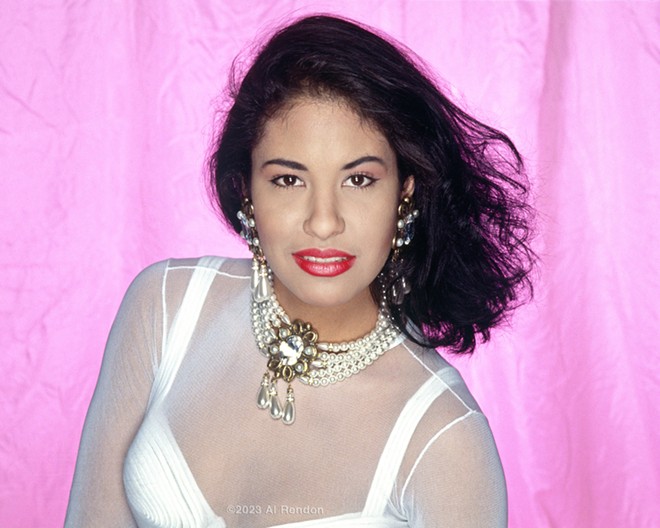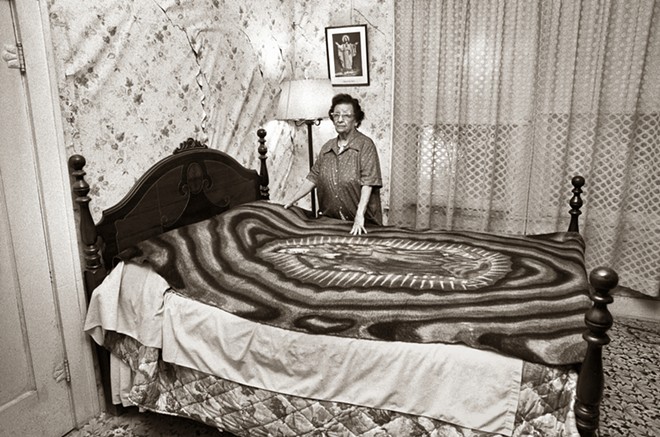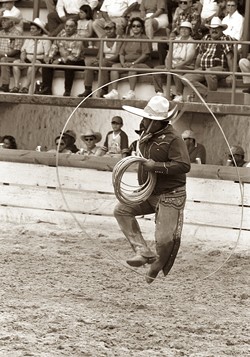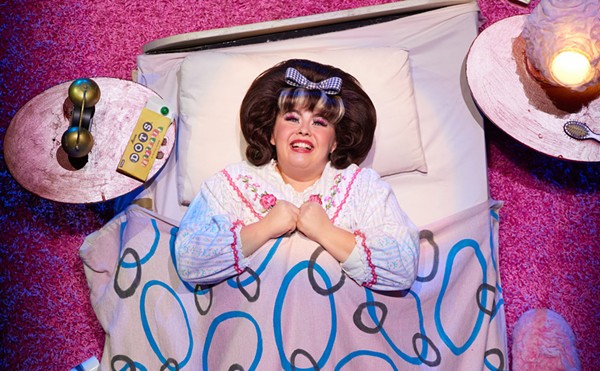
Given San Antonio photographer Al Rendon's high profile and decades-long career of capturing breathtaking images, it seems odd that he's only now having his first retrospective show.
Nonetheless, the Witte Museum is billing its show that opens Saturday, Sept. 2 as the first-ever retrospective for Rendon's work. Titled "Mi Cultura — Bringing Shadows into the Light," the exhibition is part of the citywide Fotoseptiembre series and is curated by Bruce Shackelford and Katherine Nelson Hall.
Spread through three rooms in the museum's South Texas Heritage Center, the exhibition covers a 50-year-period starting when Rendon was 16 years old and also includes some of his most recent work.
"Mi Cultura" encompasses Rendon's early photographs of '70s and '80s rock stars performing at local venues, his famous photographs of slain Tejano superstar Selena Quintanilla and series of works depicting the city's charreada and conjunto festivals. Never-before exhibited photos of the families of the Uvalde school shooting victims will also be on view.
Beyond Rendon's photography, the retrospective includes an educational component allowing visitors to walk through a mock darkroom, where equipment will be on display. For Rendon, it was important to highlight the evolution of photography, which moved from film to digital over the course of of his career.
"A lot of kids today are accustomed to taking pictures with their phones, and they aren't aware of the history and how much technology has changed since I started 50 years ago," Rendon said. "When I started, primarily everything was printed on black and white. You developed your own film and made your own prints in the dark room. That's not the way it happens now."
Rendon first learned about photography working for his high school yearbook, then he further refined his skills working at a professional photo lab. A largely self-taught photographer, he was first introduced to the art form through magazines and the iconic images of Edward Weston, Manuel Alvarez Bravo and Tina Modotti.

Rock 'n' roll mania
Rendon made his name as a young photographer in the 1970s shooting rock concerts at the city's Hemisfair Arena and Municipal Theater.
"My dad would listen to conjunto music all day long in his shop, and I didn't have any interest in it at the time," Rendon said. "I was listening to rock 'n' roll music and going to rock concerts until I was in my 20s."
Rendon's first rock concert to shoot was Led Zeppelin at Hemisfair Arena in 1973.
"I just happened to work at a photo lab a few blocks away," he said. "During the day, while they were rehearsing, I would go and ask to speak to management and wiggle my way in to take pictures. I was doing rock concerts from 1973 all the way up to 1986."
Stevie Ray Vaughn, Mick Jagger, Eric Clapton and Elton John were among the many musical acts Rendon photographed and published in local newspapers.
Although Rendon eventually made a living working as a commercial photographer for ad agencies, as a young Latino, it was initially difficult to get his foot in the door.
"In the late '70s and early '80s, all the ad agencies and PR agencies were run by Anglo businessmen," he explained. "And they preferred to work with other Anglo professional photographers that already had a head start on me."
It wasn't until the mid '80s when corporate America woke up to Latino audiences after census results spelled out the nation's rising Latino population and analysts spelled out the population's buying power.
The resulting mid-'80s boom in Hispanic ad agencies supplied Rendon's career with a major push.

Virgin de Guadalupe
In 1986, Kathy Vargas, then the visual arts program director at the Guadalupe Cultural Arts Center, invited Rendon to be part of an exhibition centered on the Virgin of Guadalupe.
His inclusion in the show marked a significant shift for Rendon. He credits the Guadalupe for helping him pivot from working solely as a commercial photographer to one also capable of creating fine-art photography.
"Up to that point I hadn't really exhibited any of my work as artwork,'" Rendon said. "It was more about trying to make a living as a commercial photographer with ad agencies, whoever needed photos done."
Although Rendon had never produced an image of the Virgin of Guadalupe, he knew exactly were to find one. He recalls going to his Aunt's house and asking her to stand next to her wool blanket with an image of the Virgin so that he could take a photo.
"That was the first time I started thinking of doing photography as an art form," he said of the shot. "From that point on, I started developing different artistic series and being part of shows — and even opened my open gallery."
For many Mexicans and Mexican Americans, the image of the Virgin of Guadalupe is a ubiquitous symbol of identity and holds special meaning of faith. Decades later, still has that blanket in his possession.
Awakened identity
Rendon also credits working with the Guadalupe Cultural Arts Center with opening his eyes to his own culture as a Mexican American.
"When I was coming of age in the '60s, my family very strongly pushed me to learn English and not speak Spanish and to assimilate," Rendon said. "My parents were first-generation immigrants. There was always a question of whether you were Mexican or American. I would play down being Mexican until I graduated high school. Not until I started working with the Guadalupe did I start to really get into Mexican culture."
Around that time, Rendon attended his first charreada, or Mexican-stlye rodeo, as part of an assignment for a local publication. He fell in love with the spectacle and splendor of the event and returned year after year. His black and white photos depicting the flamboyant costumes and competitors' daring feats on horseback became a popular series.
Along with the charreada, Rendon eventually took an interest in the Tejano and conjunto music he shunned as a younger man. He went on to capture the genres' stars at festivals and concerts. His portraits of Selena graced the covers of People and Newsweek and now appear in the Smithsonian's collection.
After shooting images ranging from portraits of prominent community members to slice-of-life images of everyday working people, Rendon says it was difficult culling through thousands of images to narrow the retrospective. Ultimately, he and the Witte's curators settled on 40 shots to represent his career. While the technology used to capture them has changed, the beauty of the timeless traditions and cultural representations in them remains the same.
Rendon's photos have documented not only the beauty and uniqueness of Mexican American culture but also of San Antonio, a city where that culture has been allowed to thrive. As a longtime Southtown resident, Rendon said he's benefitted from an up-close view of the city.
Indeed, more than 20 years ago, Rendon bought a 1892 building just south of downtown that served a studio, gallery and residence. He and his wife listed it for sale in January with a $2.6 million price tag in an effort to downsize.
"I like [San Antonio's] diversity and openness," Rendon said. "It's a big city with a small-town feel to it. We have this vibrant conjunto scene. We have this vibrant charreada scene. These are things you're not gonna see in other cities."
"Mi Cultura — Bringing Shadows into the Light," $10-$15, Sept. 2-Jan. 7, 2024, Witte Museum, 3801 Broadway, (210) 357-1900, wittemuseum.org.
Subscribe to SA Current newsletters.
Follow us: Apple News | Google News | NewsBreak | Reddit | Instagram | Facebook | Twitter| Or sign up for our RSS Feed
















